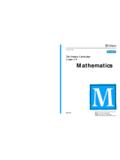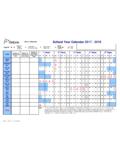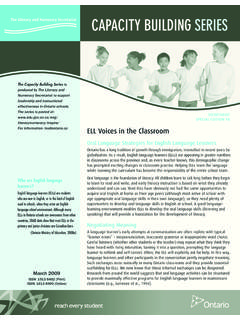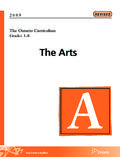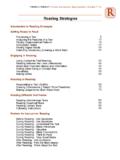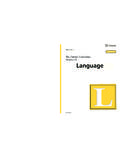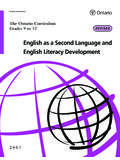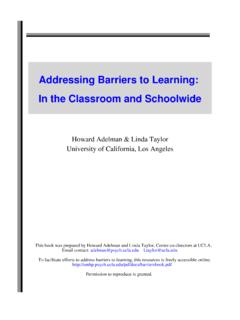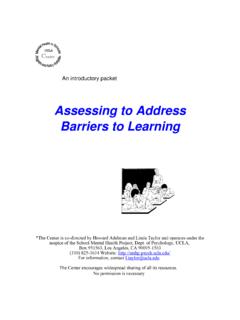Transcription of The Individual Education Plan (IEP)
1 The Individual Education plan (IEP)IEPA RESOURCE GUIDE2004 Ministry of Education Introduction ..4 What Is an IEP? ..6 Why Does a Student Have an IEP? ..7 The IEP Process ..9 Phase 1: Gather Information ..12 Gather Information From Various Sources for Program Planning ..12 Consult With Parents, the Student, School Staff, and Other Professionals ..13 Consultation with parents ..13 Consultation with the student ..14 Consultation with previous teachers ..14 Consultation with other professionals ..14 Gather Information Through Observation of the Student ..14 Conduct Further Assessments, If Necessary ..15 Consolidate and Record Information ..15 Phase 2: Set the Direction ..16 Establish a Collaborative Approach The IEP Team ..16 Establish Roles and Responsibilities ..17 The role of the educators and other professionals on the team ..17 The principal ..17 The classroom teacher ..17 The special Education teacher ..18 The teacher s assistant ..18 Other professionals.
2 18 The role of the student and parents on the team ..19 The student ..19 Parents ..19 Ways of supporting parental and student involvement ..20 Begin Work on the IEP ..20 Relevant assessment data ..22 Indicate the Student s Areas of Strength and Areas of Need on the IEP 23 Health support services in the school setting ..24 Phase 3: Develop the IEP as It Relates to the Student s Special Education Program and Services ..25 Classify Subjects or Courses and Alternative Program Areas ..25 Accommodated only ..25 Modified ..25 Alternative ..26 Classifying programs for gifted students ..271. Subjects or courses with modified expectations ..272. Alternative programs ..27 Recording classified subjects and courses in the IEP ..27 CONTENTSUne publication quivalente estdisponible en fran ais sous letitre suivant : plan d enseigne-ment individualis (PEI) : publication is available onthe Ministry of Education s website Individual Education plan (IEP): A Resource GuideRecord Decisions About Program Exemptions, Course Substitutions, and Eligibility for a Diploma or a Certificate.
3 27 Determine Accommodations ..28 Record Subjects or Courses With Accommodations Only in the IEP ..30 plan and Document Subjects or Courses With Modified Expectations .30 Elementary School Subjects ..30 Current level of achievement ..30 Annual program goal(s) ..31 Learning expectations ..32 Secondary School Courses ..33 Current level of achievement ..33 Annual program goal(s) ..34 Learning expectations ..35 plan and Document Alternative Programs or Courses ..37 Determine Teaching Strategies and Assessment Methods ..38 Teaching Strategies ..38 Assessment Methods ..38 plan For and Document Required Human Resources ..38 Record Information About Evaluation and Reporting ..39 Record Information About Provincial Assessments ..39 Develop a Transition plan , If Required ..40 Record Information About the IEP Development Phase ..41 IEP development team ..41 Sources consulted in development ..41 Parent/student consultation ..42 Completion date of the IEP development phase.
4 42 Principal s approval ..42 Parent/student response ..43 Phase 4: Implement the IEP ..44 Share the Completed IEP with the Student, Parents, School Staff, and Other Professionals ..44 Put the IEP Into Practice ..44 Classroom teachers ..44 Support personnel ..45 Continuously Assess the Student s Progress ..45 Adjust the IEP as Necessary ..46 Evaluate the Student s Learning and Report to Parents ..46 Subjects or courses with accommodations only ..46 Subjects or courses with modified expectations ..46 Alternative programs and courses ..47 Phase 5: Review and Update the IEP ..48 Update the Learning Expectations at the Beginning of Each Reporting Period ..48 Record Ongoing Revisions to the IEP ..48 Store the IEP in the Documentation File of the Ontario Student Record ..483 ContentsPlan for the Student s Transition from Elementary to Secondary School, or for a Transfer to Another School ..49 The sending teacher ..49 The receiving teacher ..49 AppendicesAppendix A: Template for a Suggested IEP Form.
5 51 Appendix B: Samples of Completed IEP Forms ..58 The Individual Education plan (IEP): A Resource Guide4 This revised resource guide replaces Part E, The Individual Education plan (IEP) ,of the ministry document Special Education : A Guidefor Educators, 2001 (pagesdated October 21), as well as the 1998 publicationIndividual Education plan (IEP):Resource present guide is intended to assist school boards in complyingwith the requirements for IEPs that are set out in Regulation 181/98 and implement-ing the policies set out in Individual Education Plans: Standards for Development,Program Planning, and Implementation, guide is intended to help teachers and others working with students with special needs to develop, implement, and monitor high-quality IEPs. A five-stepprocess is recommended. Suggestions and examples are provided, but IEPs, bytheir very nature, will be individualized on the basis of the particular requirementsof the 1 of the Education Act defines a special Education program as aneducational program that is based on and modified by the results of continu-ous assessment and evaluation and that includes a plan containing specificobjectives and an outline of educational services that meets the needs of theexceptional pupil.
6 The term special Education services is defined as facil-ities and resources, including support personnel and equipment, necessaryfor developing and implementing a special Education program .Under Regulation 181/98, Identification and Placement of Exceptional Pupils ,principals are required to ensure that an Individual Education plan (IEP) isdeveloped for each student who has been identified as exceptional by anIdentification, Placement and Review Committee (IPRC), within 30 schooldays of the student s placement in a special Education program (see excerptsfrom the regulation on page 5). School boards also have the discretion to pre-pare an IEP for a student who is receiving a special Education program and/orrelated services but who has not been formally identified as Human Rights Code provides for the right to equal treatment with respectto services, without discrimination on the basis of a number of grounds,including disability. Education is considered to be a service under the code,and service providers have an obligation to accommodate a person s needs,unless doing so causes "undue hardship for the provider, considering cost,outside sources of funding, if any, and health and safety requirements, ifany (Ontario Human Rights Code, s.)
7 17(2)). Persons with disabilities shouldbe considered, assessed, and accommodated on an Individual September 2000, the Ministry of Education released the policy documentIndividual Education Plans: Standards for Development, Program Planning, andImplementation(referred to hereafter as the IEP Standardsdocument). Thepurpose of the standards is to improve the consistency and quality of programINTRODUCTION5 Introductionplanning for students who are receiving special Education programs andservices. The standards are also intended to help improve communicationwith parents1about how their child will progress through the Ontario cur-riculum (taking into account the child s Individual learning strengths andneeds) and about how that progress will be September 2002, to support implementation of the standards, the ministryprovided school boards with an IEP template and accompanying explanatorynotes. Although use of the template is not mandatory, boards were encour-aged to revise their existing IEP forms to capture all the information repre-sented in the template.
8 A slightlyrevised version of the original template isprovided in Appendix A. (Samples of completed IEPs can be found inAppendix B.) The present resource document elaborates on the explanatorynotes, providing guidelines forplanning a student s special Education programRegulation 181/98, Sections 6 (2) (8) and 86.(2) The board shall promptly notify the principalof the school at which the special Education pro-gram is to be provided of the need to develop anindividual Education plan for the pupil in consul-tation with the parent and, where the pupil is 16 years of age or older, the pupil.(3) The Individual Education plan must include,(a) specific educational expectations for thepupil;(b) an outline of the special Education programand services to be received by the pupil; and(c) a statement of the methods by which thepupil s progress will be reviewed.(4) Where the pupil is 14 years of age or older,the Individual Education plan must also include a plan for transition to appropriate post-secondary school activities, such as work, furthereducation, and community living.
9 (5) Subsection (4) does not apply in respect of apupil identified as exceptional solely on the basisof giftedness.(6) In developing the Individual Education plan ,the principal shall,(a) consult with the parent and, where the pupilis 16 years of age or older, the pupil; and(b) take into consideration any recommendationsmade by the committee [IPRC] or the SpecialEducation Tribunal, as the case may be,regarding special Education programs or special Education services.(7) In developing a transition plan under subsec-tion (4), the principal shall consult with suchcommunity agencies and post-secondary educational institutions as he or she considersappropriate.(8) Within 30 school days* after placement of thepupil in the program, the principal shall ensurethat the plan is completed and a copy of it sentto a parent of the pupil and, where the pupil is16 years of age or older, the principal shall ensure that the Individual edu-cation plan for a pupil is included in the recordkept in respect of the pupil under clause 265(d)of the Act, unless a parent of the pupil hasobjected in writing.
10 *As amended by Ontario Regulation 137 Parentsis used throughout this document to refer to parent(s) and guardian(s).The Individual Education plan (IEP): A Resource Guide6and for developing an IEP that meets the requirements of the IEP Standardsdocument. The text is structured according to the five phases of the IEPprocess, as shown in Figure 2, on page revised resource guide is based on information gathered between 2001and 2003, when the Ministry of Education conducted reviews of IEPs pre-pared by school boards across Ontario. It takes into account informationgleaned from numerous consultations with educators and parents. Thereader may notice some minor differences between the IEP Standardsdocu-ment and this guide. These slight differences came about as terms and pro-cedures were clarified for the purpose of developing a practical guide tomeeting the requirements outlined in the IEP Standardsdocument, and theyin no way contradict the intent of the the convenience of users of this guide, several key sections of Regula-tion 181/98 are reprinted on page 5 and quoted at relevant points throughoutthe text.
